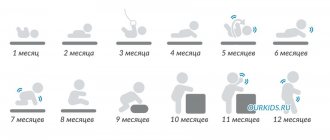The four-month-old baby has one more month of life left behind him. During this time he became very strong, grew up and learned a lot. Adapting to the baby’s new needs and capabilities, his daily routine must also change. It will still consist of alternating feedings, periods of sleep and wakefulness, filled with educational games, gymnastics and hygiene procedures, only the duration of these periods will change.
Approximate daily routine for a 4 month old baby:
- 6:00-8:00 Morning awakening, first meal, a set of hygiene procedures (with mandatory washing and changing a diaper), taking air baths combined with morning exercises, a period of active wakefulness.
- 8:00-10:00 Morning dream.
- 10:00-12:00 Second meal, active leisure (exercise, light massage, communication with loved ones, educational games).
- 12:00-14:00 A walk combined with sleep in the fresh air (about the first walks).
- 14:00-16:00 Third meal, tour of the apartment, active games, educational activities.
- 16:00-18:00 Evening walk, getting to know the outside world, sleep.
- 18:00-21:00 Fourth meal, games and educational activities with family members, bathing the baby.
- 21:00-22:30 Preparation for sleep.
- 22:30 Night meal.
- 23:00-6:00 Night sleep.
Additional option (optional):
Moms should understand that the suggested daily routine is approximate and you should not go out of your way to follow it minute by minute. The individual characteristics of each child will inevitably make their own adjustments. .
However, with any adjustments to the daily routine of a four-month-old baby, the following points should remain unchanged:
- the intervals between meals should be at least four hours;
- the total duration of daytime sleep is about six hours (it is advisable to divide them into three intervals).
Nutrition
The routine regulating the life of a 4-month-old child provides for not six, but five feedings a day. This is its main difference from the regime in the previous month . Modern mothers have the opportunity to feed their children in one of three ways: breastfeeding, artificial and mixed feeding.
- A four-month-old breastfed baby does not yet feel the need for additional complementary feeding, since the nutritional value of mother's milk is quite sufficient for him . The reduction in the number of meals is explained by the fact that an older and stronger child sucks out more milk at one feeding, remaining full longer;
- The daily requirement for breast milk for a 4-month-old baby is 900-1000 ml, so it is easy to calculate that the volume of one serving should be about 200 ml. A bottle with exactly this amount of formula is what a bottle-fed baby receives.
We read in detail about how much breast milk or formula a child should eat -
One important event occurs in the life of artificial babies: starting from this month they begin to receive their first complementary foods . Regarding the nature of foods with which complementary feeding should be started, the opinions of pediatricians are divided. Some of them believe that the best option is gluten-free, non-dairy cereals, while others recommend feeding babies with kefir and cottage cheese. The vast majority of experts advise gradually introducing vegetable purees and juices into the child’s diet, and then fruit ones.
The baby’s reaction to complementary feeding is important: he should like the food. Starting with a teaspoon, the amount of the new product is increased by one spoon daily. After ten days, the volume of complementary foods should be at least 150 ml. As soon as this happens, one feeding with a new product appears in the child’s diet, and the other four are carried out with the usual milk formula.
Complementary feeding is also introduced into the diet of 4-month-old babies, who, due to necessity, are mixed-fed. Usually mothers who produce insufficient breast milk resort to it. With this feeding scheme, the baby needs 500 ml of mother's milk, 400 ml of formula and 150 ml of complementary foods.
Article on the topic: the first feeding of children on IV
Dream
At 4 months of age, a baby's need for sleep is still high. As in the previous month, he should sleep at least sixteen hours a day, however, the increased duration of daytime wakefulness leads to a change in sleep patterns.
In an ideal situation, the baby should sleep at least ten hours at night and six during the day. Instead of four periods of daytime rest, he has three.
[sc:rsa]
Of course, this regime is not suitable for every child. Some babies still need four naps a day, while others do just fine on just one. Some sleep peacefully all night long, while others even wake up every three hours at night and require reinforcement. At this age, you can already understand who will be a “lark” and who will be an “owlet.”
In each specific case, an intelligent and caring mother must structure her baby’s daily routine in such a way as to provide him with conditions for proper development, and this is only possible with a reasonable alternation of periods of sleep and wakefulness. A baby who has slept poorly will be capricious, refuse to play and eat, and an overslept baby will become overly energetic. So the golden mean is important here too.
With a thoughtful approach, you can adapt to any individual characteristics of each baby, forcing him to get used to the correct routine . If the baby does not sleep well at night, preventing his loved ones from sleeping, it makes sense to sacrifice the first part of his night's rest and put him to bed a little later than usual. You will have to show some ingenuity when entertaining a naughty baby, but after that he will instantly fall asleep, not waking up until the morning.
How to teach a baby to sleep through the night / our daily routine from 4 months:
On the topic of sleep:
- How to put a child to sleep without tears and whims -;
- We teach a child to sleep in his crib separately from his mother (video, real stories) - https://razvitie-krohi.ru/razvitie-rebenka-do-goda/kak-priuchit-rebenka-spat-otdelno.html;
- Should you rock your baby to sleep before bedtime: up to what age can you rock him to sleep - ;
- The child sleeps only in his arms, but when he wakes up, it’s a problem or not;
- At what age can a child sleep on a pillow?
Walks
The organization, duration and number of walks with the child remain the same as in the previous month: it is necessary to take him out into the fresh air for 1.5-2 hours twice a day . Of course, if the weather conditions are not too bad: severe frost, wind or unbearable heat.
We should not forget that the beginning of a walk should be educational for the baby, who has begun to show an active interest in the world around him, so it is necessary to tell him about everything that comes along the way: about the plants, animals and birds he saw, about passers-by and vehicles passing by.
The child will still sleep peacefully in the stroller for the rest of the walk: thanks to the influx of fresh air, saturating the brain cells with oxygen, this sleep will be especially long and beneficial for him.
Educational games
Since a 4-month-old baby is awake for eight hours, this time needs to be filled with a lot of educational games.
- Walking tours around the apartment are very useful for the baby. Traveling in the arms of adults, he becomes acquainted with the name and purpose of the objects in it. All information received is stored in his memory. After some time you can verify this. Name some familiar object, and you will see that the baby will turn its head in its direction;
- To develop tactile sensations, it is useful to give your baby bright toys with different surface textures. They can be hard and soft, smooth and rough, lumpy and with holes. The colors of toys should be either monochromatic or contain no more than two or three colors. The boundaries of the color transition must be clear;
- Four months of age is a fertile time for the use of educational mats, entertainment centers and mobiles. Promoting the development of hearing, vision and fine sensory skills, awakening the baby’s motor activity, all these toys are very useful for him, but you should not offer your baby several items at once: he should focus on one thing;
- It is useful for children to listen to rhythmic music. By clapping her hands to the beat of the music, the mother will help develop a sense of rhythm in the baby. You can take the baby in your arms and gently spin around with him to a beautiful melody;
- The child needs to tell fairy tales, sing children's songs, read poems and nursery rhymes. From this age, children should be taught to look at pictures and read books;
- Games with their hands and feet, finger games-fun “Magpie-Crow”, “Ladushki”, “Horned Goat” (+10 games that bring joy to your baby) are very useful and loved by children. Stroking and massaging tiny fingers contributes not only to the development of sensory perception, but also to the activation of brain centers responsible for speech.
Knowing that all toys and objects that fall into the baby’s hands will certainly end up in his mouth, it is necessary to monitor their cleanliness. Toys should be washed daily with boiled water, and shreds should be washed periodically.
https://www.youtube.com/watch?v=d9EPxbIeAiw
Physical development, hardening and hygiene procedures
A stronger baby needs more physical exercise, so in addition to morning exercises, it is necessary to strengthen and develop his muscles throughout the day. A five-minute exercise performed in the morning, afternoon and evening will be optimal. .
- Babies of this age begin to roll over onto their tummy on their own. To make this task easier for them by strengthening the back and abdominal muscles, it is very useful to play “Kolobok”. By carefully rolling the child from back to tummy (and in the opposite direction) across the large bed, you can accompany your actions with a cheerful comment that the baby has turned into a rubber ball or a bun running away from its pursuers;
- To strengthen the spine and arms, the mother can let the baby grab onto her index fingers and then pull him towards herself. This exercise will prepare for independent sitting skills (when will the baby start sitting?);
- When laying the baby (lying on the floor) on his tummy, it is useful to place your hand under his heels. Pushing off from it with his legs, the baby will make his first attempts to crawl away. For these attempts to be successful, the floor must not be slippery. The best option is to have a carpet covered with a thin blanket.
READ ALSO: child development at 4 months and what a child should be able to do at 4 months: skills at 4 months
How to harden a baby
4 months is a very suitable age for starting hardening procedures. If performed regularly, they will allow the baby to always remain healthy. .
- Hardening began in the first months of the child’s development, since air baths and walks in the fresh air also fall into the category of hardening procedures. The duration of air baths in a room with a temperature of 22 degrees for a baby should be at least ten minutes. They should be performed at least twice a day;
- One of the most gentle hardening procedures using water is rubbing . Before moving on to wet rubdowns, a course of dry rubdowns is carried out. The baby's delicate skin is wiped with a mitten made of terry cloth. This should be done very carefully, until the skin becomes slightly red. After 7-10 days, when rubbing becomes habitual, you can start using a wet mitten. After moistening it with warm (36 degrees) water and squeezing it well, first wipe only the child’s face. After several sessions, the rubdown area is gradually increased, reaching a complete rubdown of the entire body. The duration of the procedure is no more than two minutes. After every three procedures, the water temperature is reduced by one degree (it needs to be brought to 30 degrees).
READ ALSO: How to start hardening a newborn baby. Rules and methods of hardening
The set of hygiene procedures for the child remains the same, including the procedure of morning washing, mandatory washing with each diaper change and evening bathing.
By following the proposed recommendations and adapting them to the individual characteristics of her 4-month-old baby, every caring mother will be able to create a daily routine that is necessary for the successful intellectual and physical development of the baby.
← daily routine at 3 months daily routine at 5 months →
Baby food
A four-month-old baby is fed five times due to the fact that the baby can eat more at a time.
Baby 4 months He doesn't need complementary feeding while he is pregnant because he has enough milk.
If the child is bottle-fed, then instead of taking formula, he can be given complementary foods in the form of vegetable puree or grated cottage cheese with kefir.
The total volume of the mixture is 1 liter per day, the child needs about 200 ml at one time. When choosing complementary foods, you need to pay attention to the baby’s tastes and introduce new dishes gradually. For the first time, one teaspoon is enough. After about a week, you can give 150 milliliters at a time. If such an amount is eaten by the baby with joy, one feeding can be replaced with complementary feeding.
If the mother produces little milk, mixed feeding is used. Then the baby eats both breast milk and formula. The proportion during mixed feeding is individual. On average, the ratio is as follows: breast milk - 500 milliliters, formula - 400, 150 milliliters goes to complementary foods.
Dream
Now the little one sleeps about 16 hours a day, but in small chunks. On average, these are two periods of sleep during the day and one at night. Some children sleep three times during the day, but this significantly shortens the night (and longest) rest.
Most often, the child falls asleep immediately after feeding or during a walk. And if the conditions for his normal sleep are met, he is deep and healthy. In order for your baby to sleep soundly and carefree, it is very important to observe some points:
- Microclimate of the room . For a four-month-old baby, it is important that the air temperature is around 18-20°C with an air humidity of 50-70%. The air itself should be fresh, so don’t be too lazy to ventilate the room 15 minutes before going to bed.
- Comfortable clothes . It doesn’t matter whether at home or in a stroller outside, the baby should be comfortable. Wrinkled seams, hot or synthetic clothing will prevent the baby from resting properly.
- Good diaper . The better quality and more spacious this “device” is, the less likely it is that the baby will “earn” skin irritation or wake up because it is wet and unpleasant.
A separate topic is the process of falling asleep. Very often it is difficult to put a child to bed, especially in the evening. In the evening, the little one experiences all possible unpleasant sensations, and in addition, he is tired of the volume of information received during the day.
Following a certain algorithm will help to make the evening bedtime process easier:
- played something calm with mom (or dad);
- did some light exercises and a massage;
- bought;
- ate;
- lullaby, and sleep.
Instead of a lullaby, you can use “white noise for newborns.” It will calm the baby and help him close his eyes faster. Once your baby gets used to his daily routine, putting him to sleep will be much easier.
What is the mode for?
First of all, the daily routine is important for the child himself. The human body functions according to certain biorhythms. Some are owls, some are early risers. Some people need to eat three times a day, while for others, two times is more than enough. The child is also subject to the rhythm of life. You have probably already noticed that, at a minimum, the toddler sleeps and eats at approximately the same time.
Children are impressionable people. Any stress negatively affects their health and development. A clear daily routine solves the problem of stress as much as possible. If your baby is used to eating at 7 am, try feeding him earlier or later - whims cannot be avoided. When every day you act strictly in order, adhering to the same schedule, the baby behaves much calmer - he knows for sure that now he will be fed, now he will be played with, and now he will be taken out for a walk.
Secondly, the mother needs a regime. In addition to taking care of the baby, there is also the mother herself with her needs, and there are a lot of household chores. And then the little one is yelling, and now understand what he wants. In the case of a daily routine, everything is simpler - the mother knows for sure that at 12 noon the baby whines because he is hungry, and already at one o’clock he is capricious because of the desire to take a nap. In addition, knowing exactly when the child will sleep and how much, you can plan other chores, breakfast, lunch or a basic shower.











